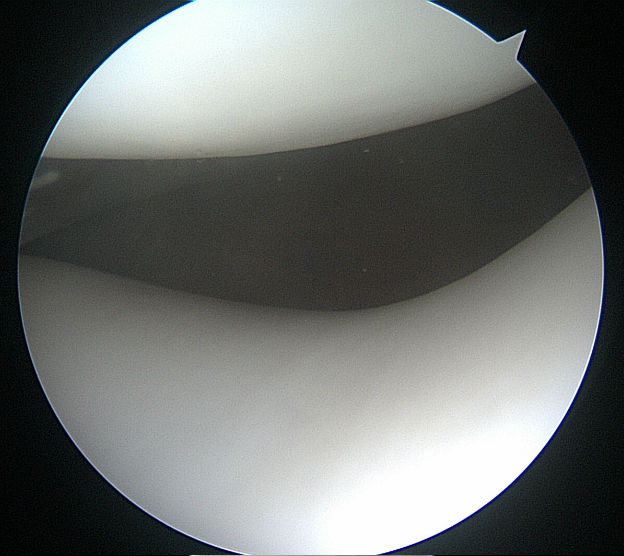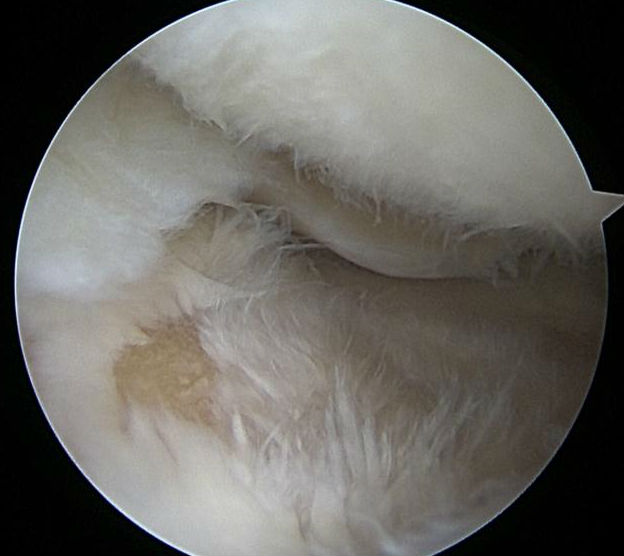Arthritis is a destructive process of the joint cartilage (the 'gristle') covering the ends of the bones, exposing the sensitive bone underneath and causing pain and eventual deformity.
 Page updated December 2023 by Dr Sheila Strover (Clinical Editor)
Page updated December 2023 by Dr Sheila Strover (Clinical Editor)

This photo was taken during keyhole surgery, and shows normal white shiny joint cartilage protecting the ends of the femur and tibia in the knee.

Arthritic damage of the joint cartilage, showing fibrillation and fragmentation. This cartilage is no longer protective, and the pain-sensitive cream-coloured bone is becoming exposed.
What causes knee arthritis?
There are many types and causes of knee arthritis, but the type which is most common is 'osteoarthritis'. In some patients there is no obvious cause, but in most the osteoarthritis is commonly the result of 'wear-and-tear' - often starting with damage to the shock-absorbing meniscus, which then leads to an alteration of the forces through the joint, so that one side bears more load and starts to wear down. Excess weight is an aggravating factor, and genetics and diet may also play a role.
Osteoarthritis tends to be troublesome in the older age group, although the initiating damage may have occurred years before. Blood tests and X-rays will usually distinguish between the various kinds of knee arthritis.
Is knee arthritis always osteoarthritis?
Osteoarthritis is not the only type of arthritis that can affect the knee. Another important type is rheumatoid arthritis, which is an auto-immune condition and commonly affects a younger age group. Rheumatoid arthritis patients may also often feel generally unwell.
Certain patients may develop yet another kind of knee arthritis due to gout, which is a disturbance of uric acid in the body. This is characterised by sudden red painful and swollen flare-ups of the knee.
Very occasionally an infection like tuberculosis (TB) can cause arthritic knee destruction.
What are the symptoms of osteoarthritis of the knee?
Osteoarthritis in the knee is usually slow in onset, becoming symptomatic gradually. Pain commonly starts on one side of the knee, and is aggravated by exercise. The knee may feel warm during flare-ups. Pain is often worse at night. Later on the gnawing pain is associated with swelling and a feeling of heat in the joint. A crunchy feeling called 'crepitus' is commonly palpable in the knee. As the arthritis progresses, there may be a loss of range of motion as well as deformity in the joint.
Is knee arthritis curable?
Doctors tend to take different approaches in the management of osteoarthritis depending on their particular line of interest - a general practitioner may tend to look at general factors such as weight and diet, a rheumatologist may prescribe anti-inflammatories, including steroids, and knee surgeons tend to take a mechanical approach and try and sort out any structural problems.
The earlier the arthritis is recognised the better. For example, a damaged knee meniscus (shock absorber) may put strain on one side of the joint, and in the early period an improvement of footware may help shift the pressures through the joint, as may a walking aid. An 'unloader brace' may help to relieve the pain during periods of exercise. Attention to muscle strength and balance may also help to take some of the strain off the joint.
Osteotomy may help the younger patient by surgically re-balancing the forces through the knee, and may reduce the need for a knee replacement in later years.
Quick links
Forum discussions
- "KNEE ARTHRITIS - General principles of managing Osteoarthritis of the knee"
General arthritis board on the KNEEguru forum
Peer-reviewed papers
-
Quote:
"results from a multifactorial, complex interplay of constitutional and mechanical factors, including joint integrity, genetic predisposition, local inflammation, mechanical forces, and cellular and biochemical processes...."
Citation: Lespasio MJ, Piuzzi NS, Husni ME, Muschler GF, Guarino A, Mont MA. Knee Osteoarthritis: A Primer. Perm J. 2017;21:16-183. doi: 10.7812/TPP/16-183. PMID: 29035179; PMCID: PMC5638628.
 2023 - Primer -
2023 - Primer -  2009 -
2009 -